16.08.2023
Intuitive Machines sets mid-November launch date for first lunar lander
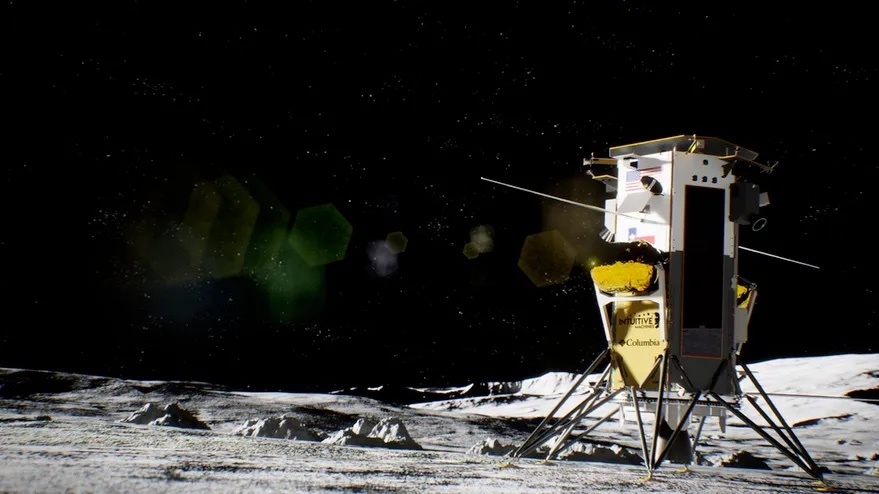
WASHINGTON — Intuitive Machines offered a clearer projection of when its first lunar lander mission will launch while also giving a cloudier forecast of its finances.
The company announced Aug. 14 as part of its second quarter financial results that its IM-1 lunar lander mission is slated for launch on a Falcon 9 during a six-day window that opens Nov. 15 at Launch Complex 39A at the Kennedy Space Center. A backup launch window is available in December.
During an earnings call, Steve Altemus, chief executive of Intuitive Machines, said the company was wrapping up testing of the Nova-C lander for IM-1 in advance of shipment to Cape Canaveral. “Today, our IM-1 lander is complete and will be prepared for delivery in September.”
He cautioned, though, that the date was subject to availability of the Eastern Range and of LC-39A, which is used for crew and cargo missions to the International Space Station and Falcon Heavy launches. “With the congestion for launches using pad 39A at Kennedy Space Center, we recognize that higher-priority missions are always possible,” he said.
IM-1 is not only the first lunar lander mission by Intuitive Machines but also potentially the first lander as part of NASA’s Commercial Lunar Payload Services (CLPS) program. Astrobotic’s Peregrine lunar lander is complete but awaiting the readiness of its launcher, United Launch Alliance’s Vulcan Centaur. That rocket’s inaugural flight, with Peregrine as the prime payload, is planned for no earlier than the fourth quarter.
IM-1 is the first of three lunar lander missions that the company has in development as part of CLPS. Altemus said the company is building the lander structure and integrating NASA payloads for the IM-2 mission. He did not give a projected launch date for IM-2, which was once expected to launch before the end of the year, several months after IM-1.
He said the company is awaiting a decision on a proposal for another CLPS mission, designated CP-22 by NASA, to deliver a drill to the lunar south pole. However, he said the agency has delayed the award of that task order from the third quarter of 2023 to November.
The company said schedule slips in contract awards like the CLPS task order was one reason the company was withdrawing earlier financial guidance it offered. The company had earlier forecast revenues of $174 million to $268 million for the year, ending 2023 with a cash balance of $49 million.
Intuitive Machines reported $18 million in revenue in the second quarter, primarily from its CLPS work, down from $19.2 million in the same quarter of 2022. It had an operating loss of $13.2 million and ended the quarter with $39.1 million of cash.
Erik Sallee, chief financial officer of Intuitive Machines, said on the call that “delays on government acquisition timelines and U.S. federal budget uncertainty” led the company to withdraw that guidance. He added it was not linked to any contract losses sustained by the company. “We haven’t lost anything that we previously had in our forecast,” he said. “It all shifted out to the right.”
One of those delays was with a NASA engineering services contract called Omnibus Multidiscipline Engineering Services (OMES) III. Intuitive Machines teamed with KBR to win the contract, valued at up to $719 million over five years, in April. Another bidder, SAIC, filed a protest with the Government Accountability Office in May, delaying the start of that work.
The GAO rejected the SAIC protest Aug. 8, allowing NASA to proceed with the OMES III contract award to KBR and Intuitive Machines. The value of OMES III was not included in the company’s backlog of $137.3 million it reported at the end of the second quarter, and Altemus said the company was projecting to start work on that engineering services contract in the fourth quarter.
The company also is bidding on NASA’s Lunar Terrain Vehicle contract to develop rovers to be offered as services for future Artemis crewed missions. Altemus said he expects NASA to make multiple awards under that program, potentially in the fourth quarter.
While the company only has enough cash to last three quarters at its current rate of operating losses, Sallee said that money along with revenue should be sufficient. He added, though, that the company could tap a $50 million equity financing facility “to provide further cushion, if needed.”
Quelle: SN
----
Update: 5.12.2023
.
Intuitive Machines Nova-C Lunar Lander Arrives in Cape Canaveral, Florida
Intuitive Machines, Inc. (Nasdaq: LUNR, LUNRW) (“Intuitive Machines”) (“Company”), a leading space exploration, infrastructure, and services company, has announced the successful delivery of its IM-1 mission Nova-C lunar lander to Cape Canaveral, Florida.
“Reaching this tremendous milestone has built a four-year foundation of technical excellence earned through challenges, failures, and triumph; I’m so proud of this team leading the United States back to the Moon,” said Intuitive Machines CEO Steve Altemus. “The opportunity to deliver the first of three manifested lunar landers with NASA and commercial payloads is an incredible moment for the entire commercial aerospace industry, and I’m looking forward to this launch as well as our subsequent missions in the near future.”
In coordination with SpaceX, the liftoff of the IM-1 lunar mission is targeted for a multi-day launch window that opens no earlier than January 12, 2024. In case of unfavorable launch conditions, such as poor weather, backup opportunities will be determined based on the lunar blackout window and other factors.
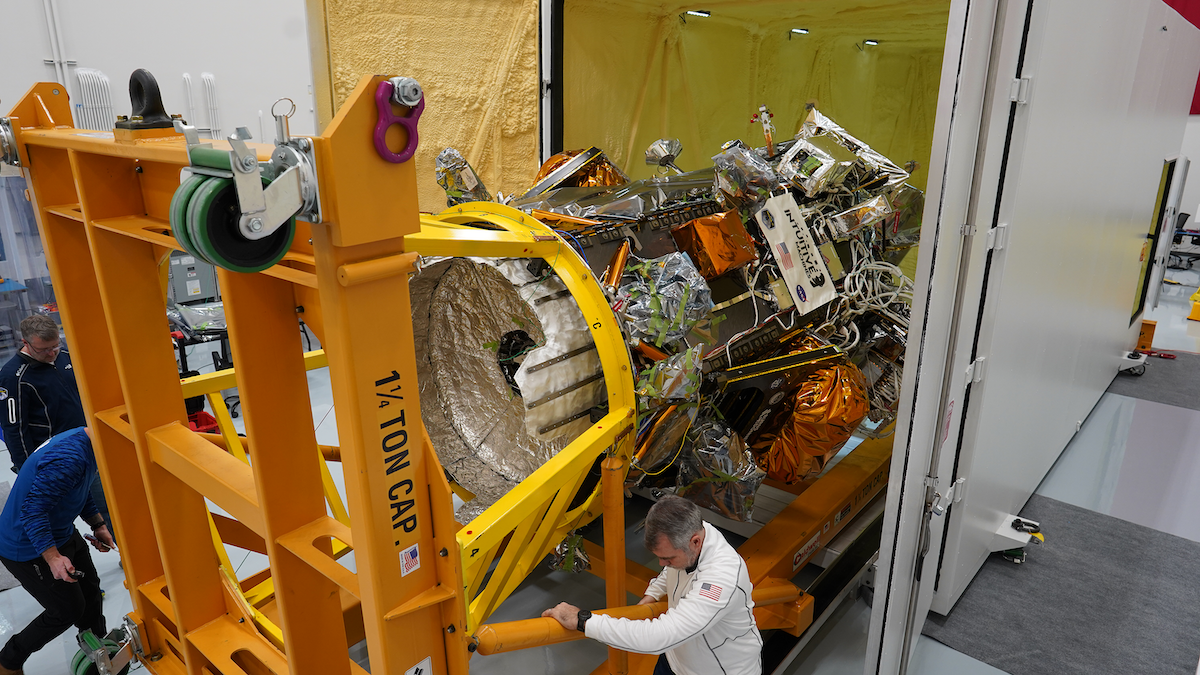
Figure 1: Intuitive Machines engineers loading the IM-1 mission Nova-C lunar lander into its custom container in Houston, TX.
The Company’s IM-1 mission will be operated from Intuitive Machines’ Nova Control Center in Houston, Texas. There, flight controllers will monitor spacecraft health, send commands, and receive data during the lander’s approximate six-and-a-half-day journey to the lunar surface using the Company’s commercially available Lunar Data Network. After landing, Intuitive Machines and its customers expect Nova-C to operate in the lunar south pole region for nearly two weeks.
As previously announced, Intuitive Machines completed the IM-1 lunar lander in September at the Company’s Lunar Production and Operations Center located at the Houston Spaceport. In late November, the lander was loaded into a custom-designed air ride ground transport system and delivered to Cape Canaveral, Florida.
IM-1 will be the Company’s first of three manifested attempted lunar landings as part of NASA’s Commercial Lunar Payload Services (“CLPS”) initiative, a key part of NASA’s Artemis lunar exploration efforts. The science and technology payloads sent to the Moon’s surface as part of CLPS intend to lay the foundation for a sustainable human presence on the lunar surface and the commercial development of the Moon.
About Intuitive Machines
Intuitive Machines is a diversified space company focused on space exploration. Intuitive Machines supplies space products and services to support sustained robotic and human exploration to the Moon, Mars, and beyond. Intuitive Machines’ products and services are offered through its four business units: Lunar Access Services, Orbital Services, Lunar Data Services, and Space Products and Infrastructure. For more information, please visit intuitivemachines.com.
Forward Looking Statement
This press release includes "forward-looking statements" within the meaning of the Private Securities Litigation Reform Act of 1995, as amended. All statements contained in this press release that do not relate to matters of historical fact should be considered forward-looking. These forward-looking statements generally are identified by the words such as “anticipate,” “believe,” “continue,” “may,” “might,” “plan,” “possible,” “potential,” “predict,” “project,” “should,” “strive,” “would,” but the absence of these words does not mean that a statement is not forward-looking. These forward-looking statements include but are not limited to statements regarding: our expectations and plans relating to our first mission to the Moon, including the expected timing of launch for our first mission. These forward-looking statements reflect the Company’s expectations based upon currently available information and data. Our actual results, performance or achievements may differ materially from those expressed or implied by the forward-looking statements, and you are cautioned not to place undue reliance on these forward-looking statements. The factors detailed under the section titled Part I, Item 1A. Risk Factors of our Annual Report on Form 10-K for the fiscal year ended December 31, 2022, the section titled Part I, Item 2, Management's Discussion and Analysis of Financial Condition and Results of Operations and the section titled Part II. Item 1A. “Risk Factors” in our Quarterly Report on Form 10-Q for the quarter ended September 30, 2023, could cause actual outcomes or results to differ materially from those indicated by the forward-looking statements in this press release, which are accessible on the SEC's website at www.sec.gov and the Investors section of our website at www.investors.intuitivemachines.com.
These forward-looking statements are based on information available as of the date of this press release and current expectations, forecasts, and assumptions, and involve a number of judgments, risks, and uncertainties. Accordingly, forward-looking statements should not be relied upon as representing our views as of any subsequent date, and we do not undertake any obligation to update forward-looking statements to reflect events or circumstances after the date they were made, whether as a result of new information, future events, or otherwise, except as may be required under applicable securities laws.
Quelle: Intuitive Machines
----
Update: 21.12.2023
.
Intuitive Machines IM-1 Lunar Mission Launch Update
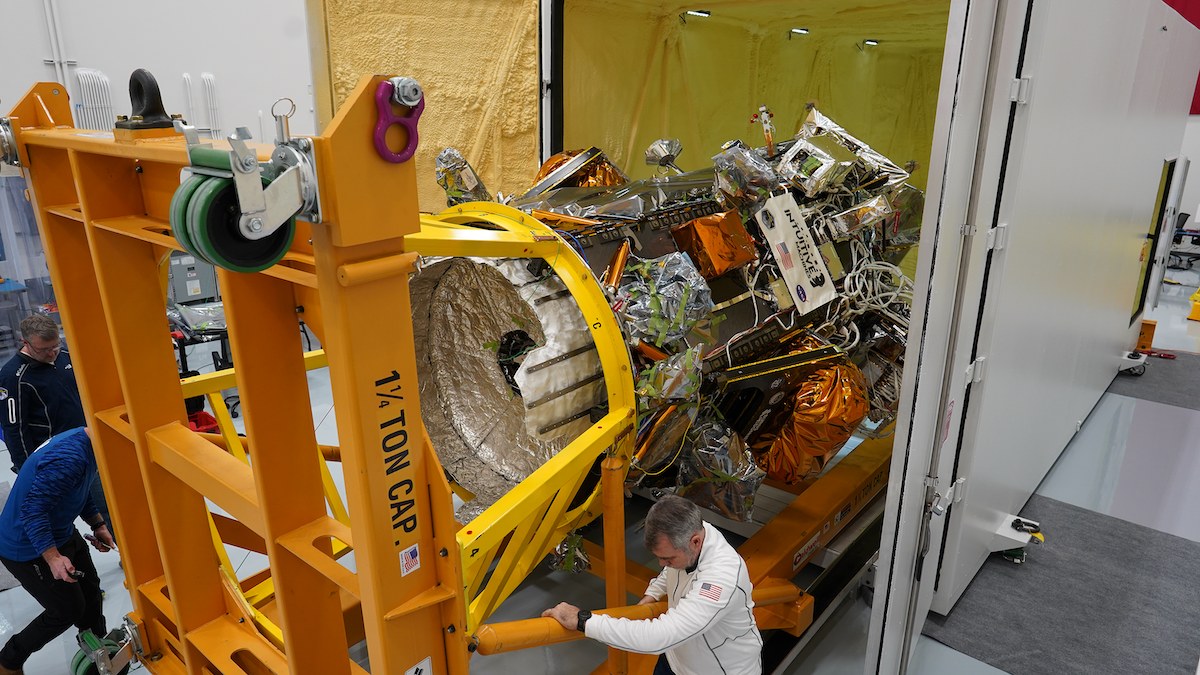
HOUSTON, Dec. 19, 2023 (GLOBE NEWSWIRE) -- Intuitive Machines, Inc. (Nasdaq: LUNR, LUNRW) (“Intuitive Machines”) (“Company”), a leading space exploration, infrastructure, and services company, announced in coordination with SpaceX, launch of the Company’s IM-1 lunar mission is now targeted for a multi-day launch window that opens no earlier than mid-February 2024. The updated window comes after unfavorable weather conditions resulted in shifts in the SpaceX launch manifest.
The mid-February launch window is the next available opportunity to launch IM-1 given the monthly lunar blackout period; the IM-1 mission Nova-C lunar lander is targeted to land near the south pole of the Moon, requiring specific lighting conditions that are only available for a handful of days each month.
The Company’s IM-1 mission Nova-C lunar lander remains ready. As previously announced, Intuitive Machines delivered its IM-1 mission Nova-C lunar lander to Cape Canaveral, Florida, earlier this month. Since arriving in Florida, the IM-1 lunar lander has completed major system tests, verification, and certification milestones and is prepared for integration with SpaceX’s Falcon 9 rocket.
The Intuitive Machines IM-1 mission will be the Company’s first attempted lunar landing as part of NASA’s Commercial Lunar Payload Services (“CLPS”) initiative, a key part of NASA’s Artemis lunar exploration efforts. The science and technology payloads sent to the Moon’s surface as part of CLPS intend to lay the foundation for human missions and a sustainable human presence on the lunar surface.
About Intuitive Machines
Intuitive Machines is a diversified space company focused on space exploration. Intuitive Machines supplies space products and services to support sustained robotic and human exploration to the Moon, Mars, and beyond. Intuitive Machines’ products and services are offered through its four business units: Lunar Access Services, Orbital Services, Lunar Data Services, and Space Products and Infrastructure. For more information, please visit intuitivemachines.com.
Forward-Looking Statements
This press release includes "forward-looking statements" within the meaning of the Private Securities Litigation Reform Act of 1995, as amended. All statements contained in this press release that do not relate to matters of historical fact should be considered forward-looking. These forward-looking statements generally are identified by the words such as “anticipate,” “believe,” “continue,” “may,” “might,” “plan,” “possible,” “potential,” “predict,” “project,” “should,” “strive,” “would,” but the absence of these words does not mean that a statement is not forward-looking. These forward-looking statements include but are not limited to statements regarding: our expectations and plans relating to our first mission to the Moon, including the expected timing of launch for our first mission. These forward-looking statements reflect the Company’s expectations based upon currently available information and data. Our actual results, performance or achievements may differ materially from those expressed or implied by the forward-looking statements, and you are cautioned not to place undue reliance on these forward-looking statements. The factors detailed under the section titled Part I, Item 1A. Risk Factors of our Annual Report on Form 10-K for the fiscal year ended December 31, 2022, the section titled Part I, Item 2, Management's Discussion and Analysis of Financial Condition and Results of Operations and the section titled Part II. Item 1A. “Risk Factors” in our Quarterly Report on Form 10-Q for the quarter ended September 30, 2023, could cause actual outcomes or results to differ materially from those indicated by the forward-looking statements in this press release, which are accessible on the SEC's website at www.sec.gov and the Investors section of our website at www.investors.intuitivemachines.com.
These forward-looking statements are based on information available as of the date of this press release and current expectations, forecasts, and assumptions, and involve a number of judgments, risks, and uncertainties. Accordingly, forward-looking statements should not be relied upon as representing our views as of any subsequent date, and we do not undertake any obligation to update forward-looking statements to reflect events or circumstances after the date they were made, whether as a result of new information, future events, or otherwise, except as may be required under applicable securities laws.
Quelle: Intuitive Machines
----
Update: 24.01.2024
.
NASA Invites Media to First Intuitive Machines, SpaceX Moon Launch
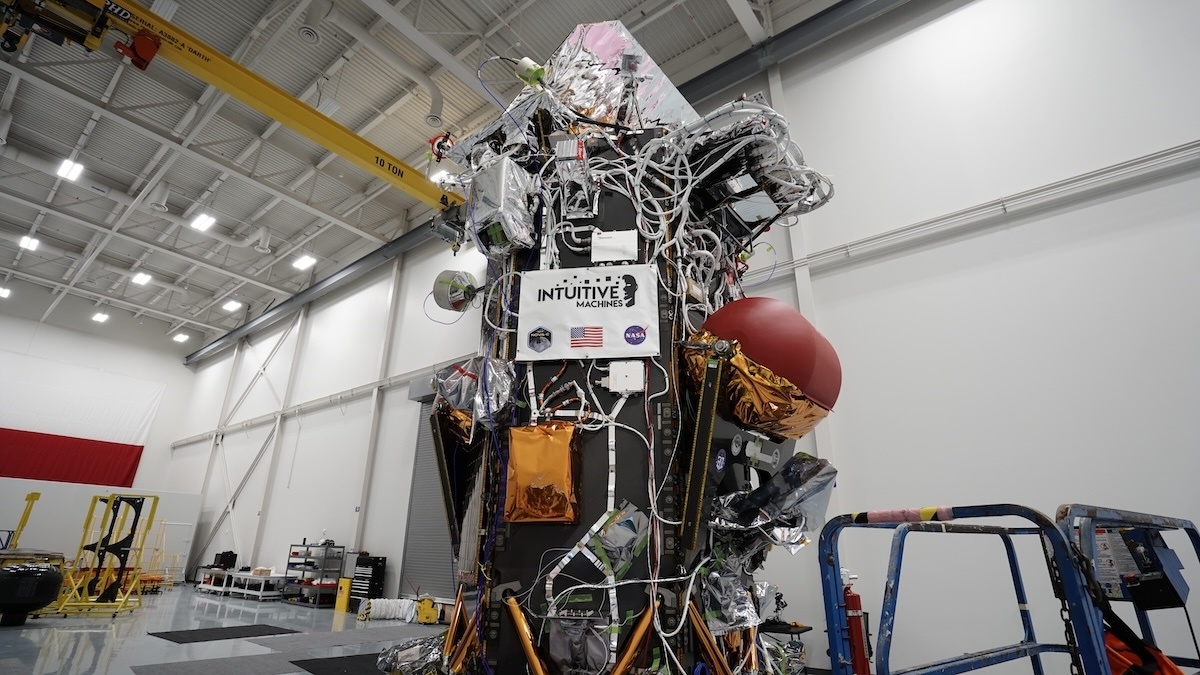
The Nova-C lunar lander is seen in the high bay of Intuitive Machines Headquarters in Houston, before it shipped to NASA’s Kennedy Space Center in Florida for integration with a SpaceX Falcon 9 rocket for launch, as part of NASA’s CLPS (Commercial Lunar Payload Services) initiative and Artemis campaign.
Credits: Intuitive Machines
As part of NASA’s CLPS (Commercial Lunar Payload Services) initiative and Artemis campaign, media accreditation is open for Intuitive Machines’ first robotic flight to the Moon’s surface. The robotic deliveries will transport agency science and technology demonstrations to the Moon for the benefit of all.
The Intuitive Machines Nova-C lander carrying NASA science and commercial payloads will launch on a SpaceX Falcon 9 rocket. Liftoff is targeted for a multi-day launch window, which opens no earlier than mid-February, from Launch Complex 39A at NASA’s Kennedy Space Center in Florida.
Among the NASA items on its lander, the Intuitive Machines mission will carry instruments focusing on plume-surface interactions, space weather/lunar surface interactions, radio astronomy, precision landing technologies, and a communication and navigation node for future autonomous navigation technologies. A successful landing will help support the CLPS model for commercial payload deliveries to the lunar surface. As the anchor customer of CLPS, NASA is investing in lower-cost methods of Moon deliveries and aims to be one of many customers.
Media prelaunch and launch activities will take place at NASA Kennedy. Media who are U.S. citizens interested in attending in person must apply for credentials no later than 12 p.m. EST on Monday, Jan. 29, by emailing media@spacex.com.
In May 2019, NASA awarded a task order for the delivery to Intuitive Machines. Through Artemis, commercial robotic deliveries will perform science experiments, test technologies, and demonstrate capabilities to help NASA explore the Moon in advance of Artemis Generation astronaut missions to the lunar surface, in preparation for future missions to Mars.
NASA is working with several U.S. companies to deliver science and technology to the lunar surface through the agency’s CLPS initiative. This pool of companies may bid on delivery task orders. A task order award includes payload integration and operations, as well as launching from Earth and landing on the surface of the Moon. NASA’s CLPS contracts are indefinite-delivery/indefinite-quantity contracts with a cumulative maximum contract value of $2.6 billion through 2028.
Quelle: NASA
----
Update: 7.02.2024
.
First Intuitive Machines lunar lander mission set for Feb. 14 launch
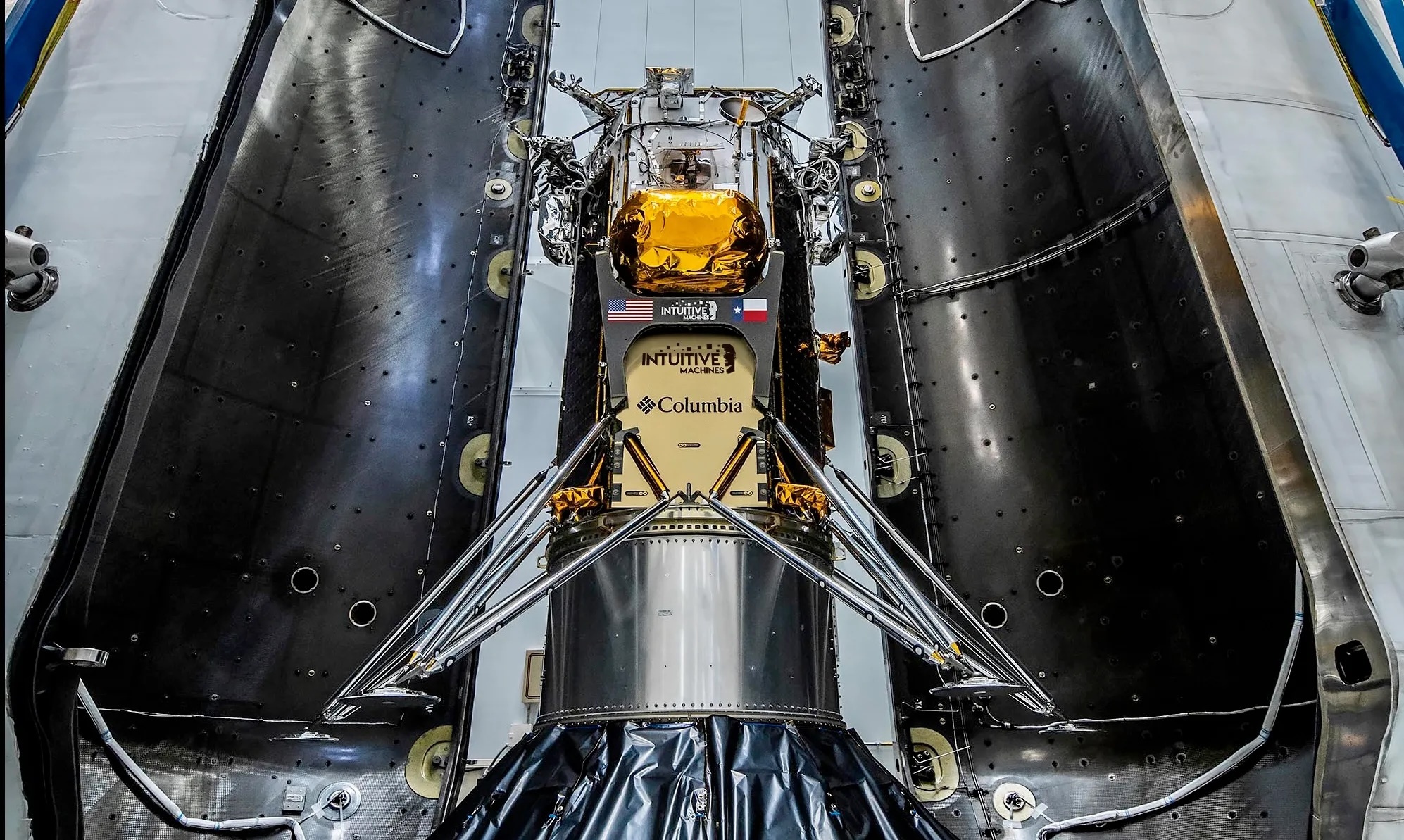
Intuitive Machines says its IM-1 lunar lander mission is scheduled for launch as soon as Feb. 14, with a tanking test scheduled for Feb. 7. Credit: SpaceX
WASHINGTON — Intuitive Machines and SpaceX have confirmed plans to launch the IM-1 lunar lander mission as soon as Feb. 14, pending a fueling test on the pad later this week.
In a Feb. 5 statement, Intuitive Machines announced it was targeting a launch of its lander in a “multi-day window” that opens Feb. 14. Liftoff of the Falcon 9 from Kennedy Space Center’s Launch Complex 39A is scheduled for 12:57 a.m. Eastern that day.
The announcement came hours after a SpaceX official, speaking at a briefing about the upcoming launch of NASA’s PACE Earth science mission on another Falcon 9, confirmed that Feb. 14 date, which had been widely known in the industry but which neither NASA nor Intuitive Machines would disclose at a Jan. 31 briefing about the agency’s payloads on the lander.
“Our Intuitive Machines launch is targeting Feb. 14, Valentine’s Day,” said Julianna Scheiman, director of civil satellite missions at SpaceX, at the Feb. 5 briefing. “We’re tracking well to a Feb. 14 launch.”
One final milestone before that launch is a fueling test, or wet dress rehearsal, scheduled for Feb. 7. That is important for IM-1 since the lander needs to be loaded with liquid oxygen and methane propellants while on the launch pad shortly before launch, a procedure that required modifications to the infrastructure at LC-39A.
“We’ll be performing essentially a tanking test, or wet dress rehearsal, for that spacecraft on Feb. 7,” she said, to confirm that the spacecraft can be fueled on the pad.
While Intuitive Machines said in its statement that it had a multi-day window, Scheiman said the mission had a three-day window, with launch opportunities Feb. 14 through 16. Intuitive Machines previously stated that a launch any day in that window would set up a landing attempt on Feb. 22.
The 675-kilogram lander, called Odysseus by the company, is carrying six payloads for NASA through a Commercial Lunar Payload Services (CLPS) award valued at $118 million. It is also carrying six commercial payloads, ranging from sportswear company Columbia to artist Jeff Koons. The commercial payloads also include Eaglecam, a camera developed by students at Embry-Riddle Aeronautical University that will eject from the lander during its final descent to the surface to attempt to photograph the landing.
If IM-1 is successful, it will be the first private mission to land softly on the moon after three previous failed attempts. The Beresheet lander by Israel’s SpaceIL crashed during its descent to the lunar surface in 2019, and the HAKUTO-R M1 lander from Japanese company ispace crashed attempting a landing in April 2023. Astrobotic’s Peregrine lunar lander suffered a propellant leak hours after its Jan. 8 launch that prevented the spacecraft from attempting a lunar landing.
Quelle: SN
----
Update: 15.02.2024
.
Six NASA Instruments Will Fly to Moon on Intuitive Machines Lander
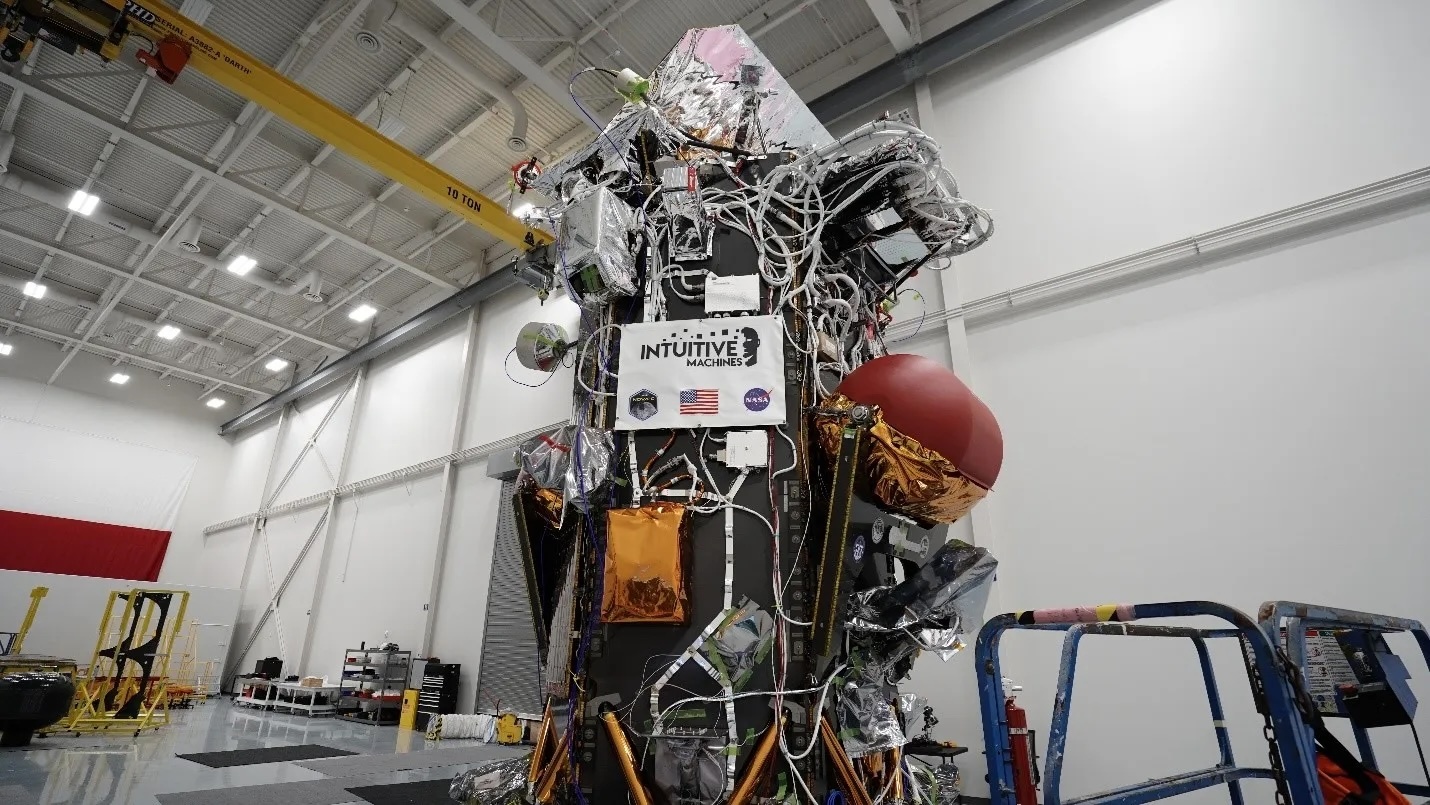
NASA is gearing up for a commercial robotic flight to the Moon under the agency’s CLPS (Commercial Lunar Payload Services) initiative and Artemis campaign. Intuitive Machines will launch its Nova-C lander on a SpaceX Falcon 9 rocket no earlier than Wednesday, Feb. 14, from Cape Canaveral, Florida. The Intuitive Machines IM-1 mission will carry six NASA payloads targeted for the South Polar region.
The group of NASA instruments aboard IM-1 will conduct scientific research and demonstrate technologies to help us better understand the Moon’s environment and improve landing precision and safety in the challenging conditions of the lunar south polar region, paving the way for future Artemis astronaut missions. The payloads will collect data on how the plume of engine gasses interacts with the Moon’s surface and kicks up lunar dust, investigate radio astronomy and space weather interactions with the lunar surface, test precision landing technologies, and measure the quantity of liquid propellant in Nova-C propellant tanks in the zero gravity of space. The Nova-C lander will also carry a retroreflector array that will contribute to a network of location markers on the Moon that will be used as a position marker for decades to come
The Nova-C lander is targeted to land Thursday, Feb. 22, in a relatively flat and safe area near the Malapert A crater, in the south polar region of the Moon.
The six NASA payloads aboard Intuitive Machines’ IM-1 mission include:
- LN-1 (Lunar Node 1 Navigation Demonstrator)
A small, CubeSat-sized flight hardware experiment that integrates navigation and communication functionality for autonomous navigation to support future surface and orbital operations. Principal investigator: Dr. Evan Anzalone, NASA’s Marshall Space Flight Center
- LRA (Laser Retroreflector Array)
A collection of eight retroreflectors that enable precision laser ranging, which is a measurement of the distance between an orbiting or landing spacecraft to the reflector on the lander. LRA is a passive optical instrument and will function as a permanent location marker on the Moon for decades to come.
Principal investigator: Dr. Xiaoli Sun, NASA’s Goddard Space Flight Center
- NDL (Navigation Doppler Lidar for Precise Velocity and Range Sensing)
A Lidar-based (Light Detection and Ranging) descent and landing sensor. This instrument operates on the same principles of radar but uses pulses from a laser emitted through three optical telescopes. NDL will measure vehicle velocity (speed and direction) and altitude (distance to surface) with high precision during descent to touchdown. Principal investigator: Dr. Farzin Amzajerdian, NASA’s Langley Research Center
- RFMG (Radio Frequency Mass Gauge)
A rocket propellant gauge used to measure the amount of spacecraft propellant in a low-gravity space environment. Using sensor technology, RFMG will measure the amount, or mass, of cryogenic propellants in Nova-C’s tanks, providing data that can help predict propellant usage on future missions. Principal investigator: Dr. Greg Zimmerli, NASA’s Glenn Research Center
- ROLSES (Radio-wave Observations at the Lunar Surface of the Photoelectron Sheath)
Four antennas and a low-frequency radio receiver system designed to study the dynamic radio energy environment near the lunar surface and determine how natural and human-generated activity near the surface interacts with science investigations. It will also detect radio emissions from the Sun, Jupiter, and Earth, as well as dust impacting the surface of the Moon. Principal investigator: Dr. Nat Gopalswamy, NASA Goddard
- SCALPSS (Stereo Cameras for Lunar Plume-Surface Studies)
A suite of four cameras to capture stereo and still images of the dust plume created by the lander’s engine as it begins its descent to the lunar surface until after the engine shuts off. Principal investigator: Michelle Munk, NASA Langley
Intuitive Machines is one of 14 vendors eligible to carry NASA payloads to the Moon through the agency’s CLPS initiative, which began in 2018. CLPS is an innovative approach connecting NASA with commercial solutions from American companies to deliver scientific, exploration, and technology payloads to the Moon’s surface and into lunar orbit. Through CLPS, NASA aims to gain new insights into the lunar environment and expand the lunar economy to support future crewed missions under the Artemis campaign.
Quelle: NASA
+++
Update: 10:00 MEZ
.
Start von SpaceX Falcon9 mit Nova-C lander IM-1
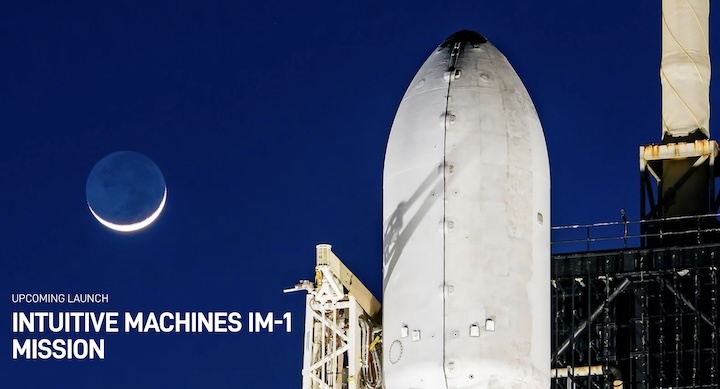
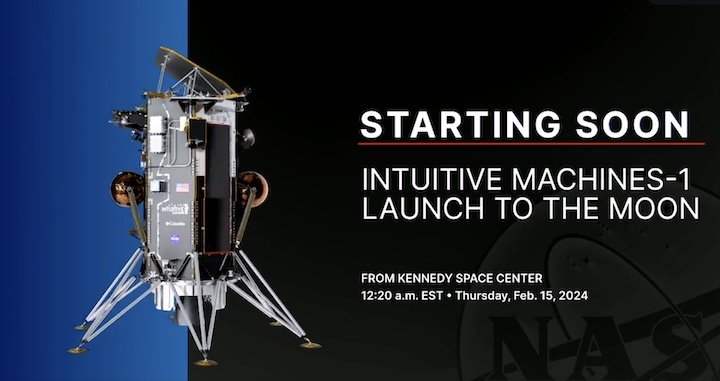
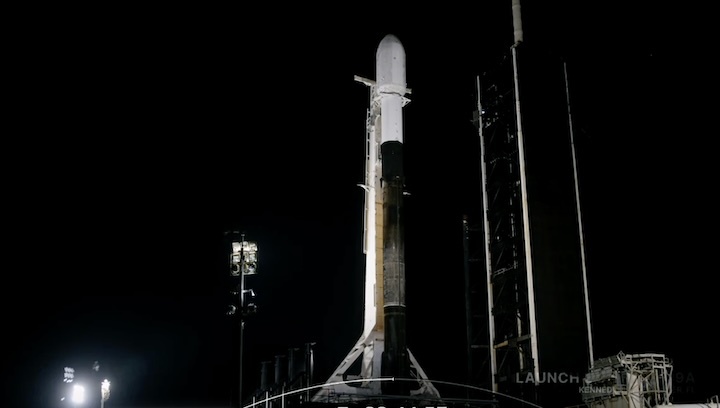
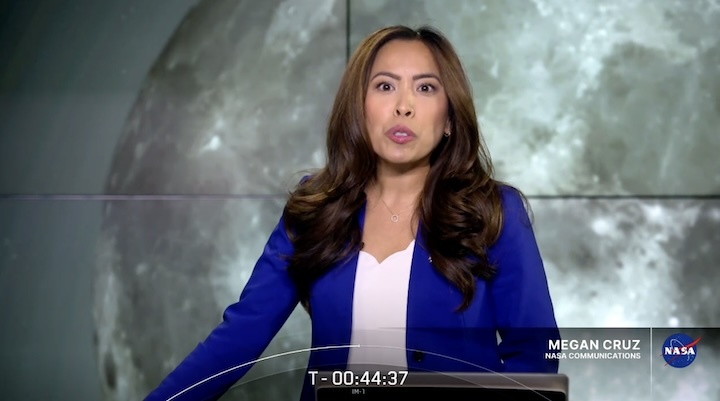
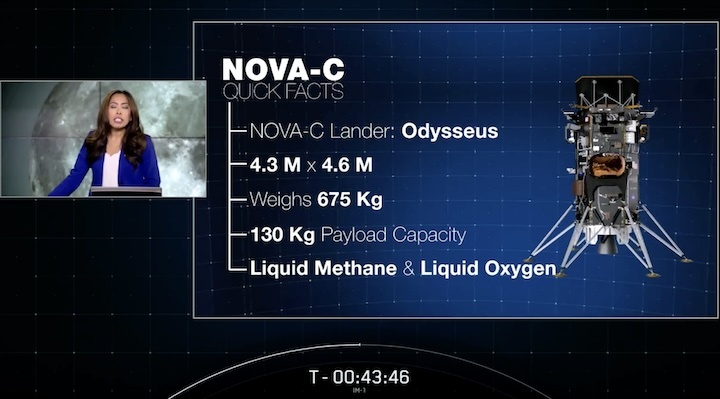
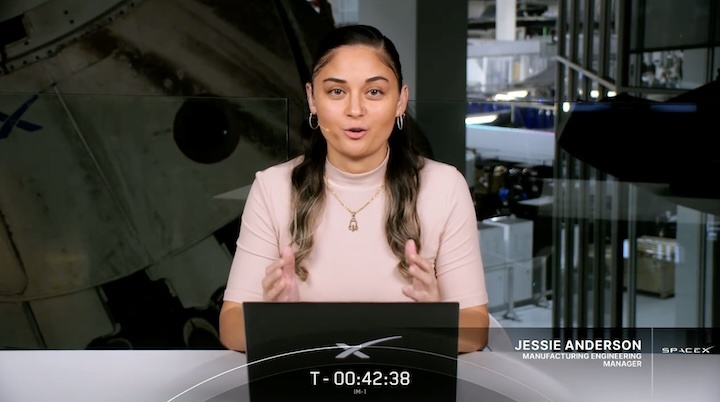
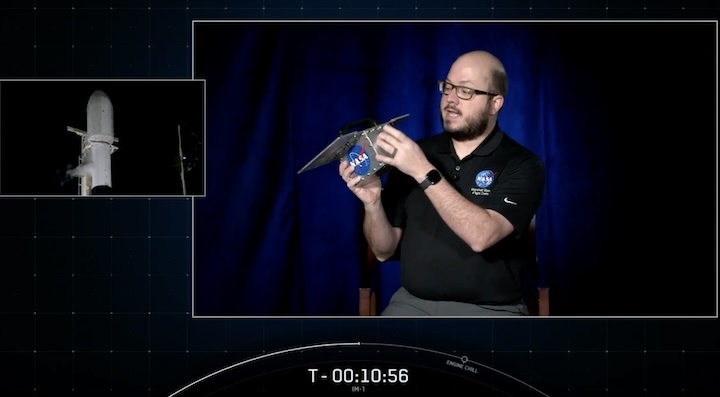
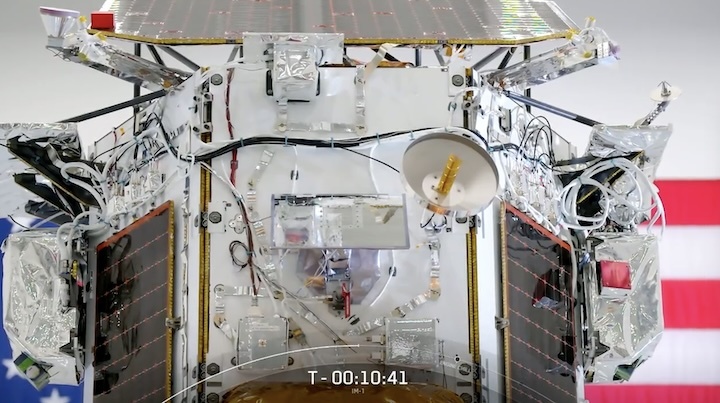
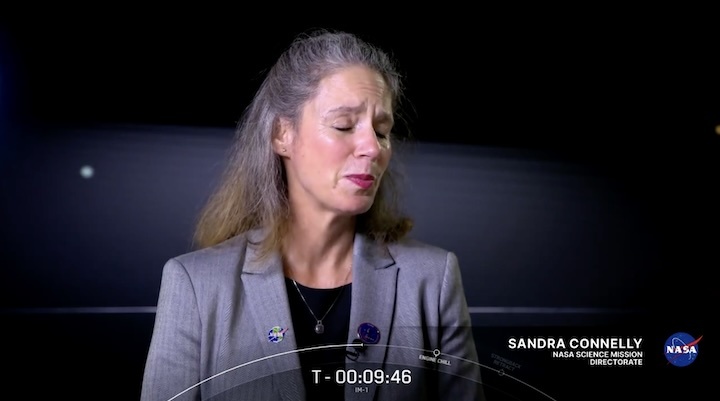
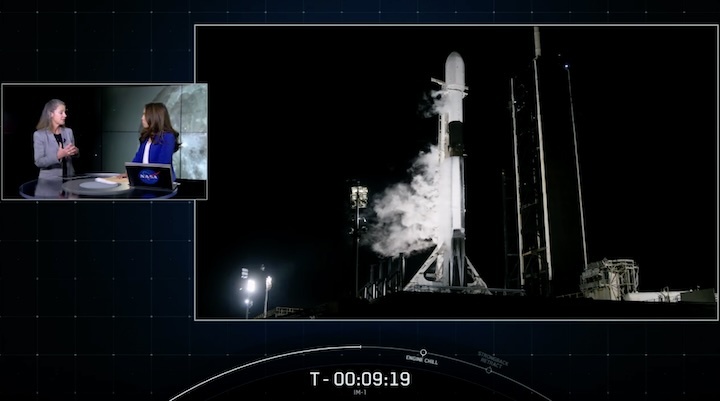
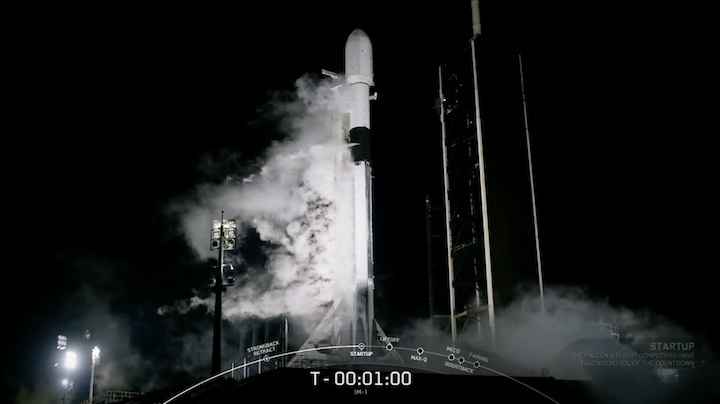
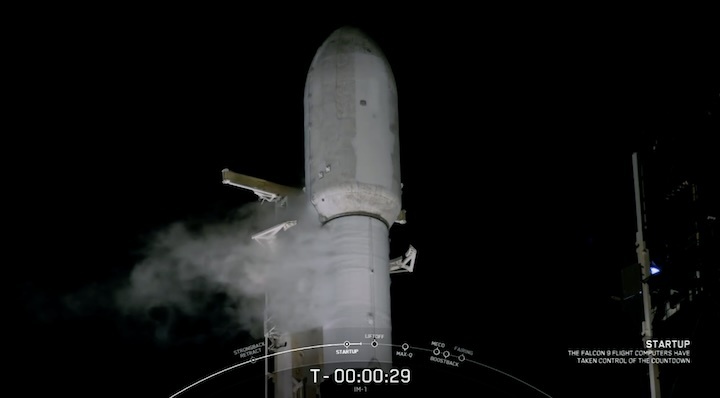
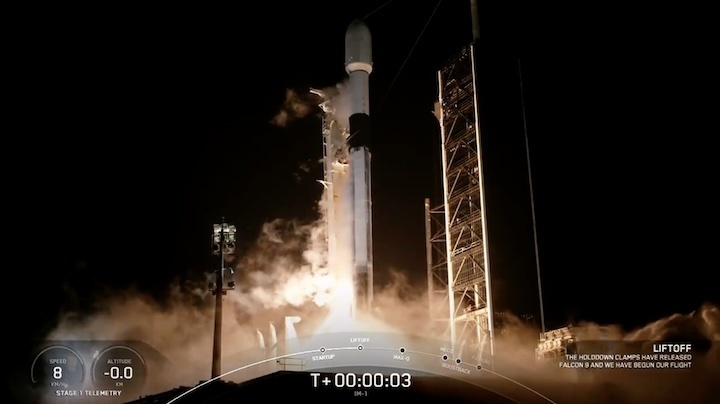
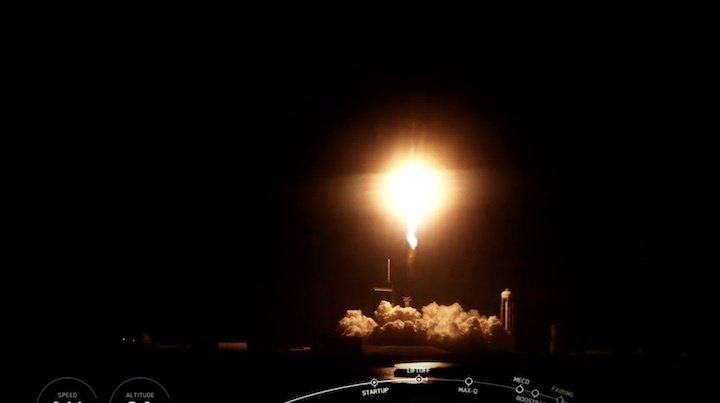
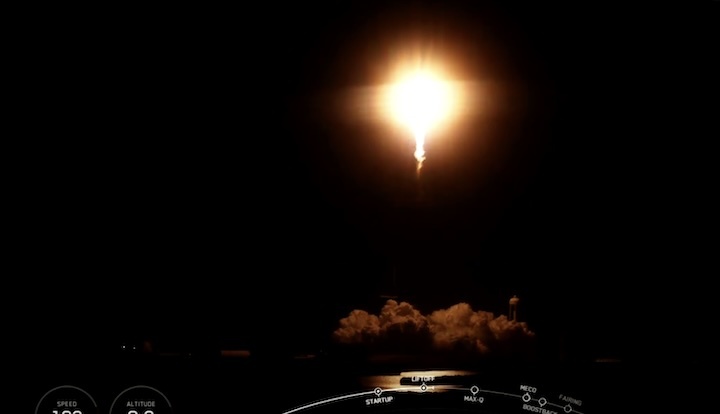
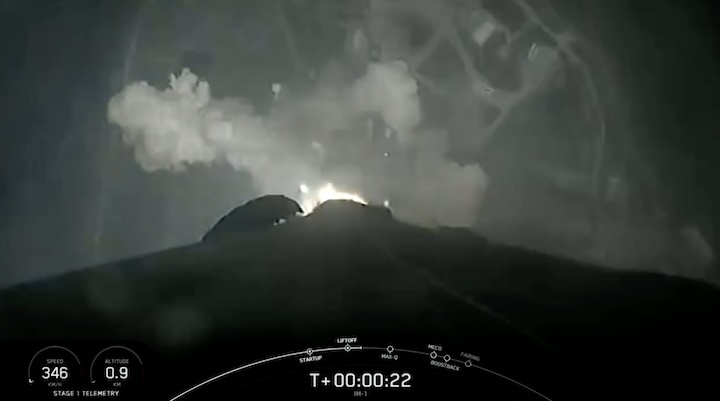
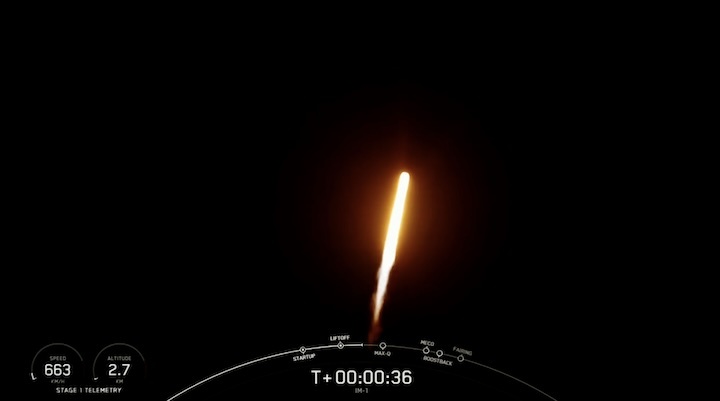
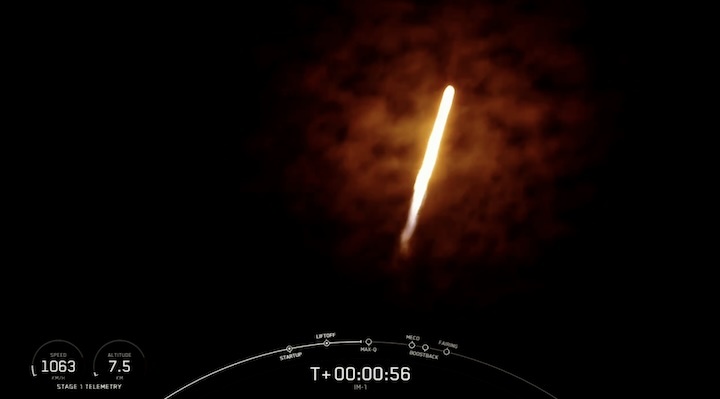
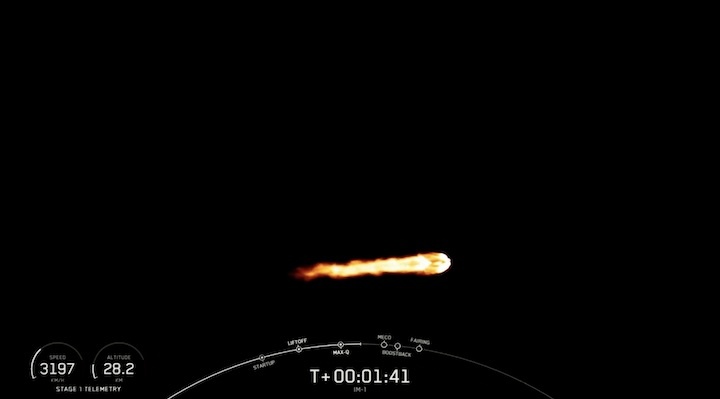
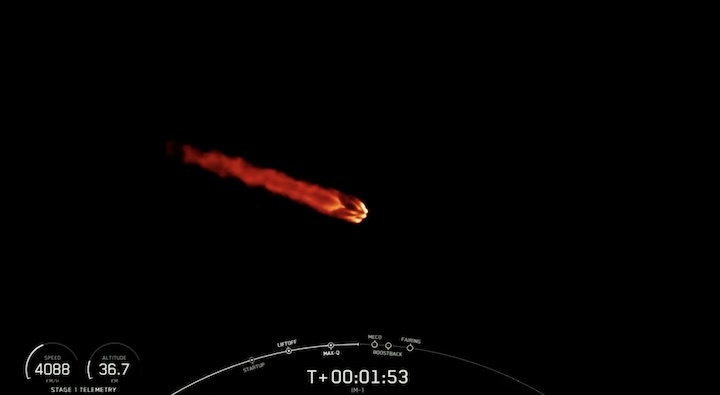
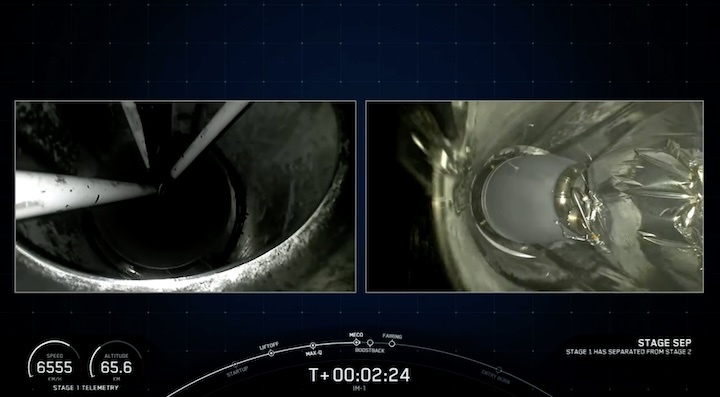
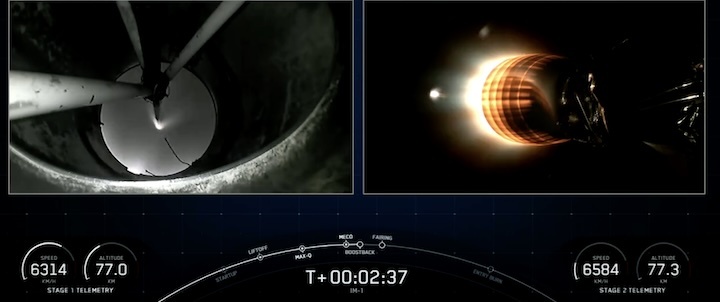
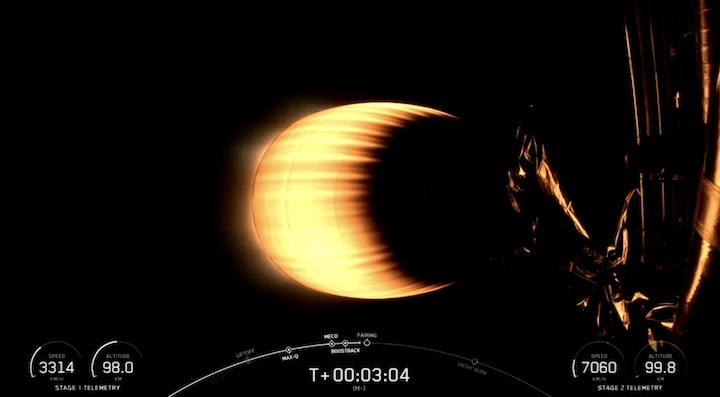
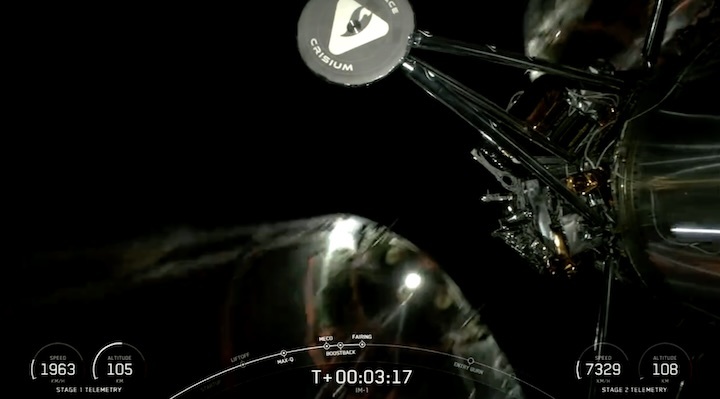
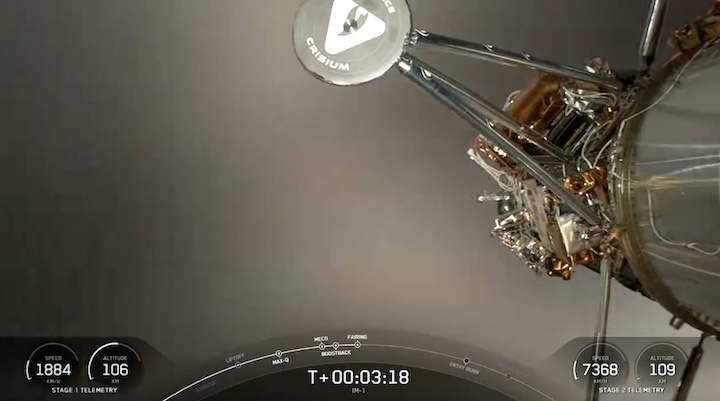
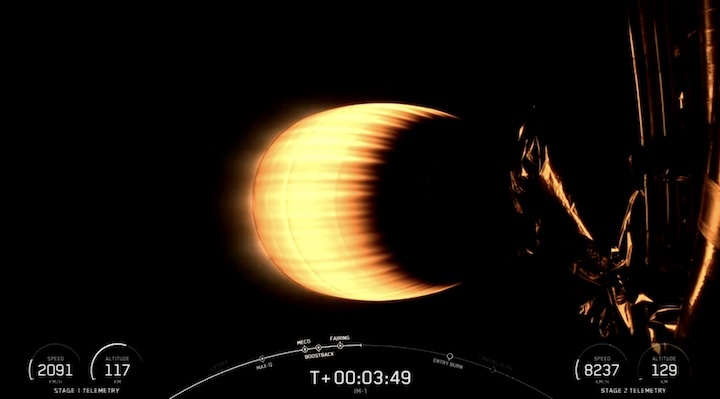
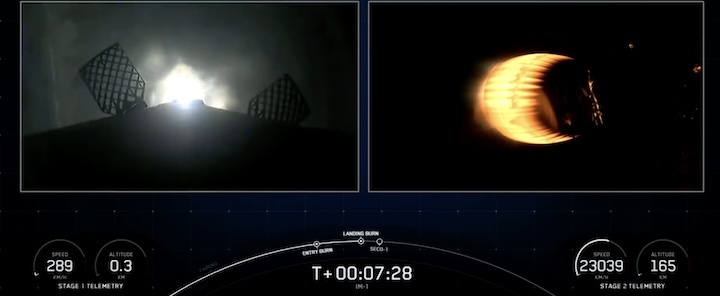



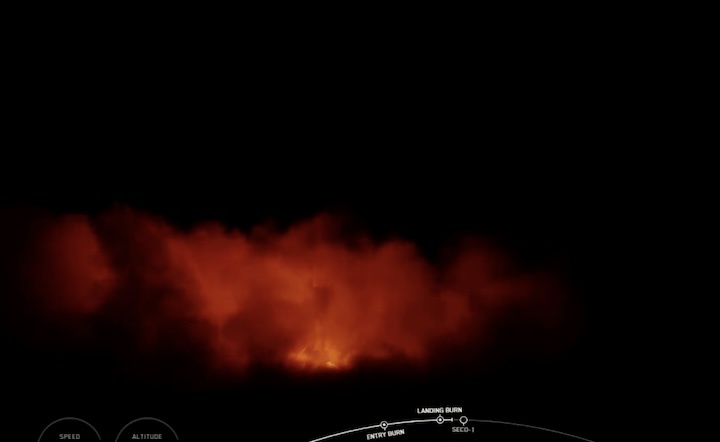
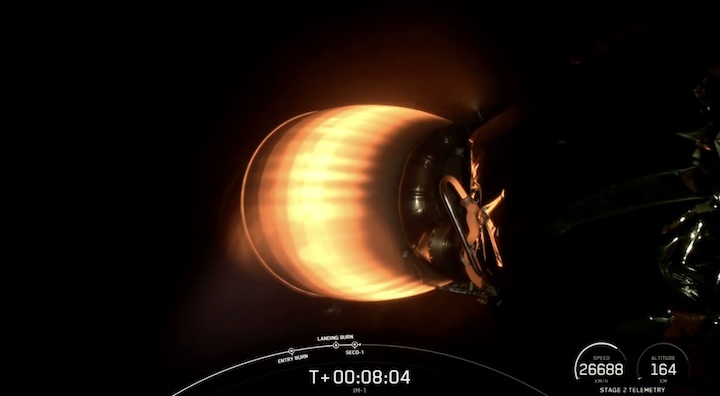
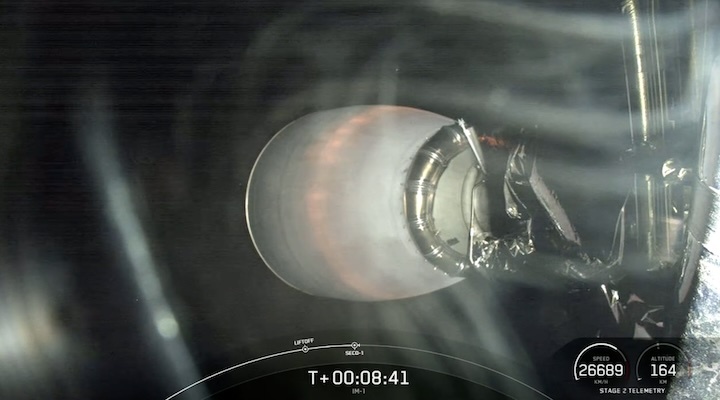
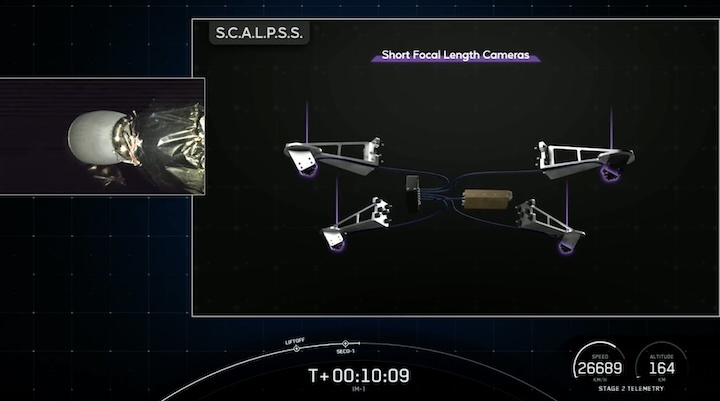
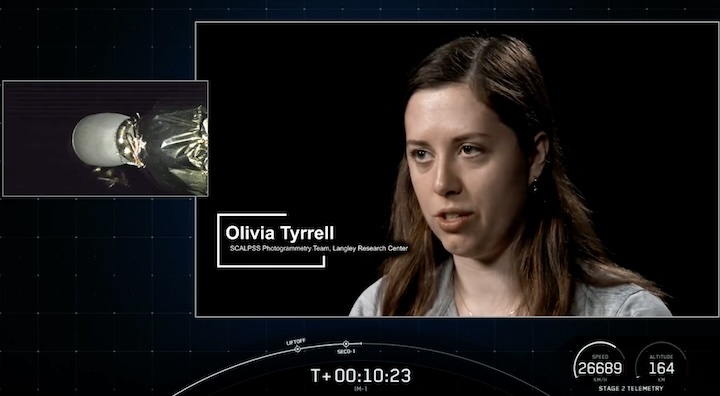
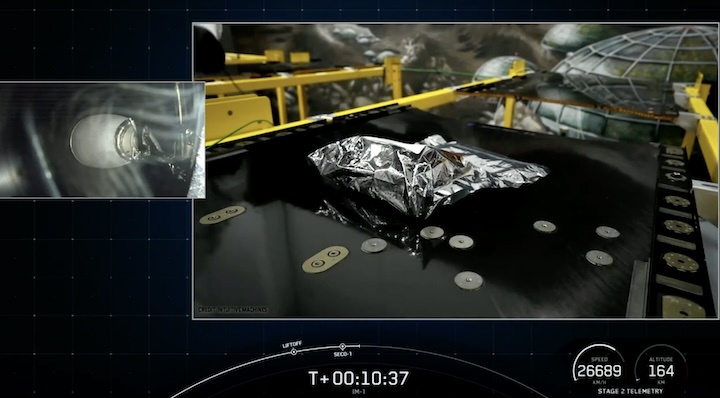
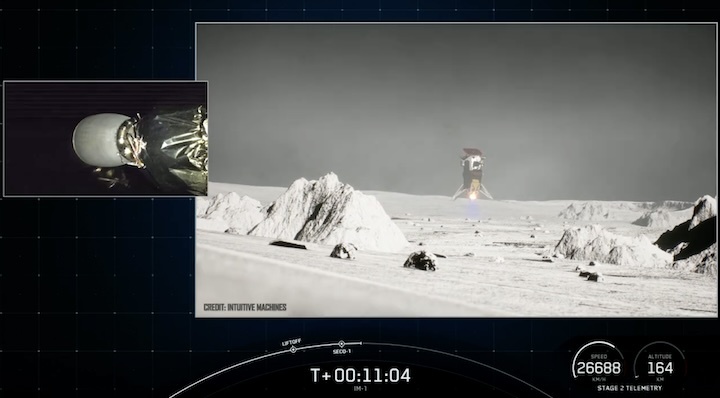
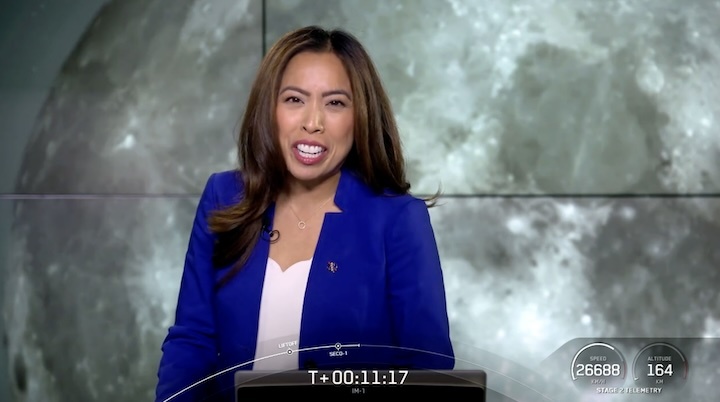
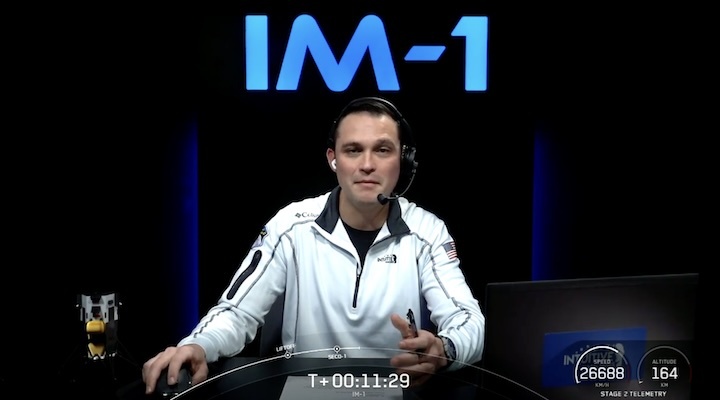
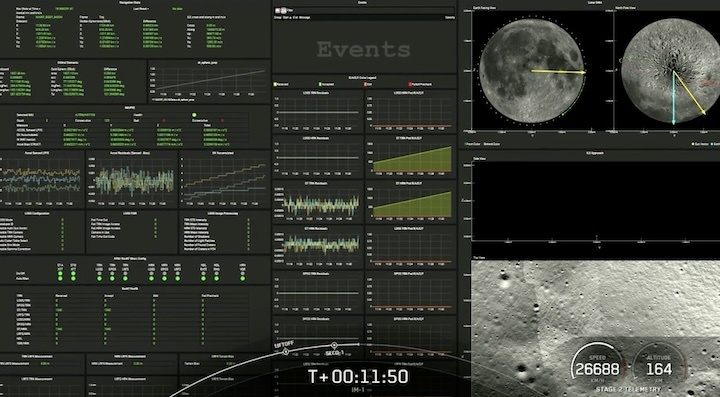
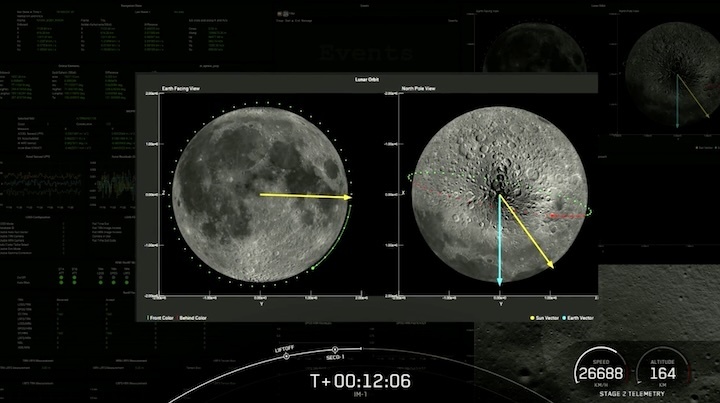
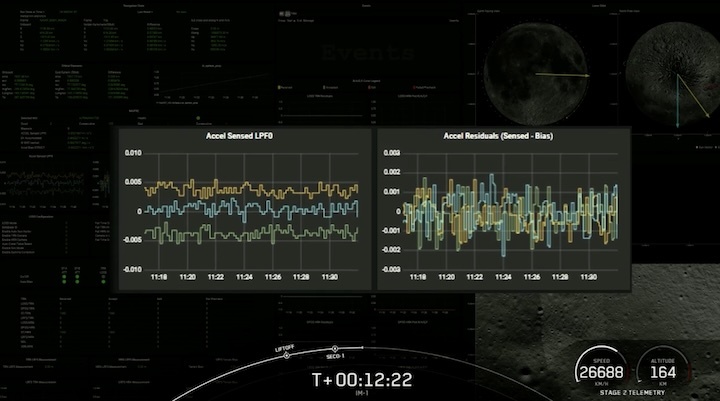
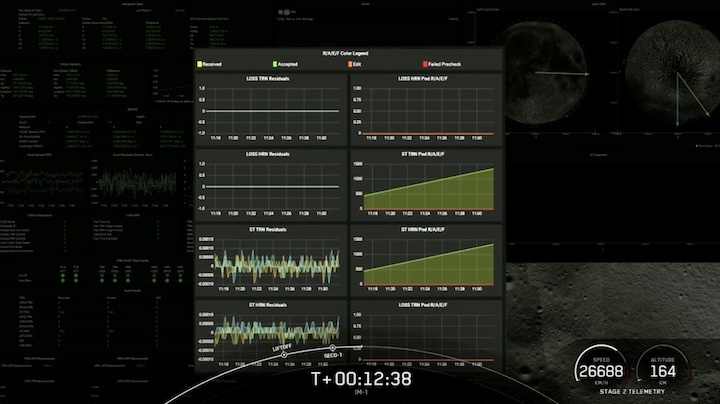
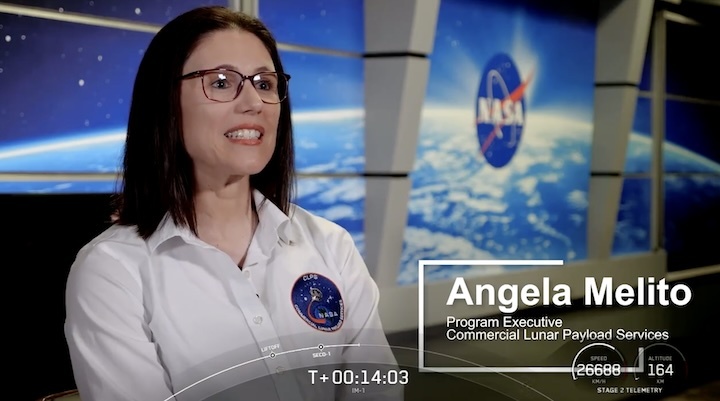
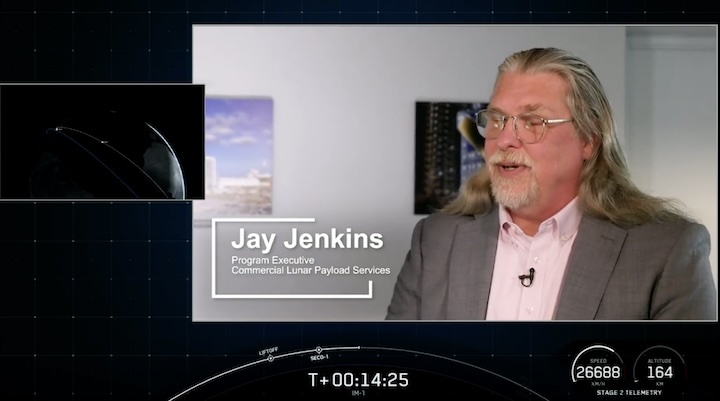
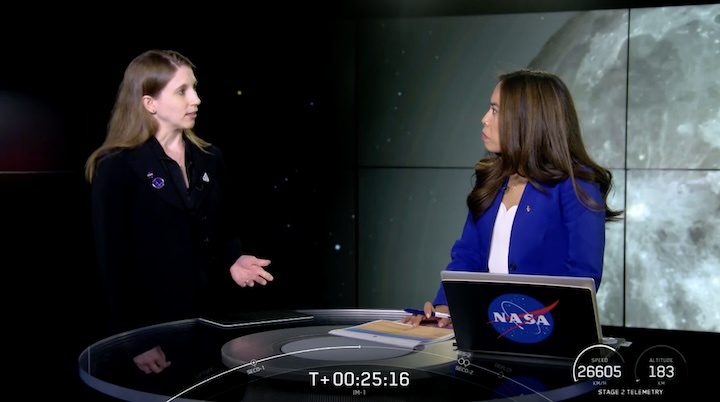
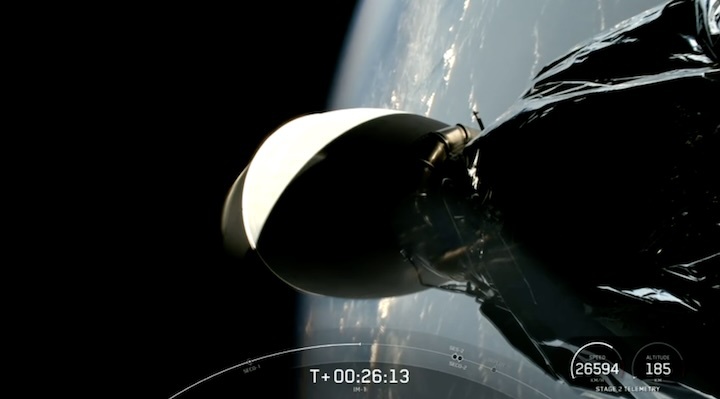
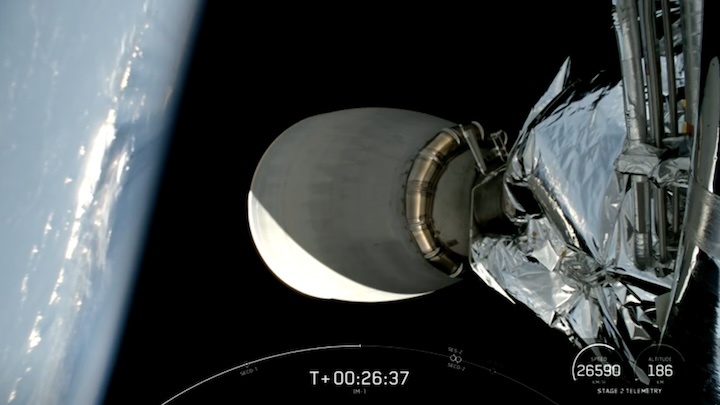
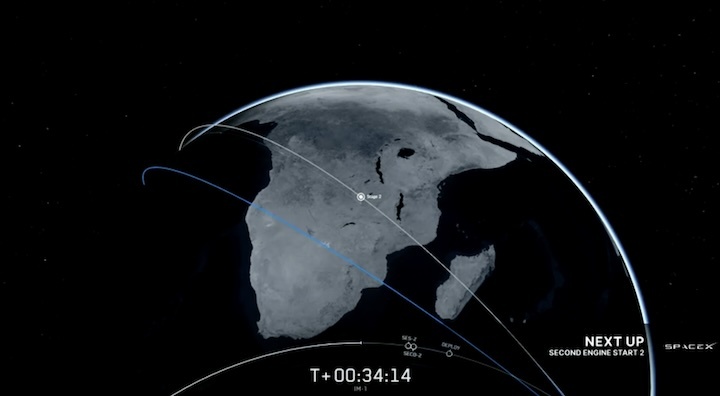
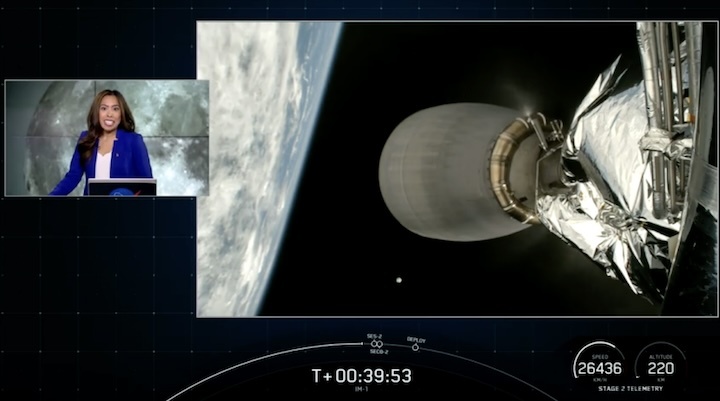
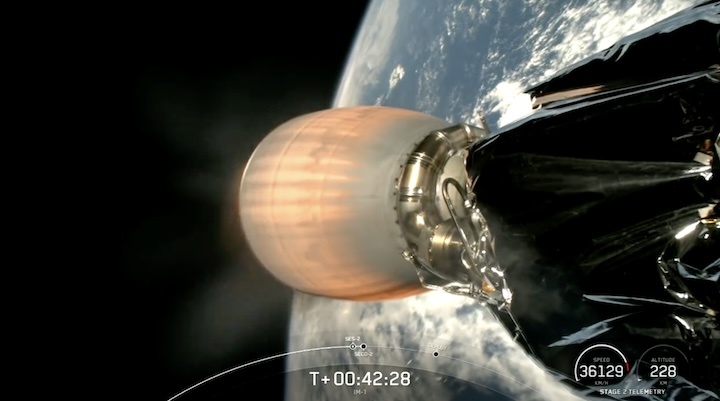
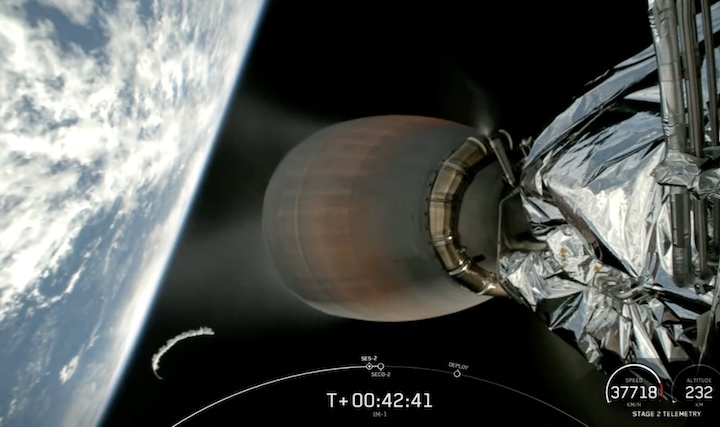
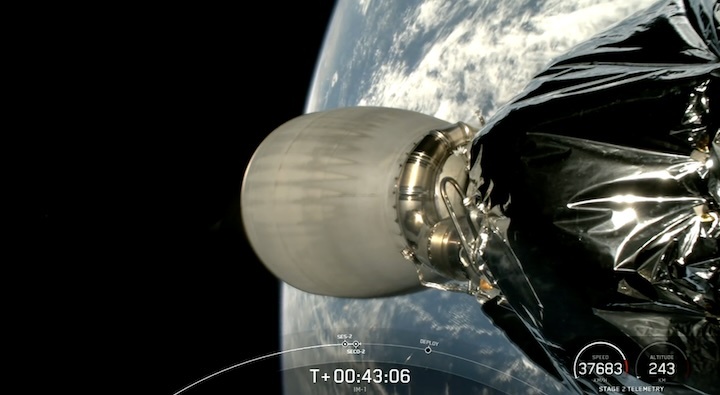
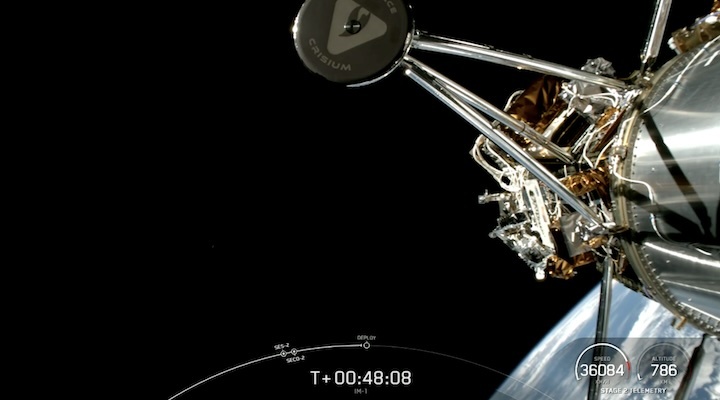
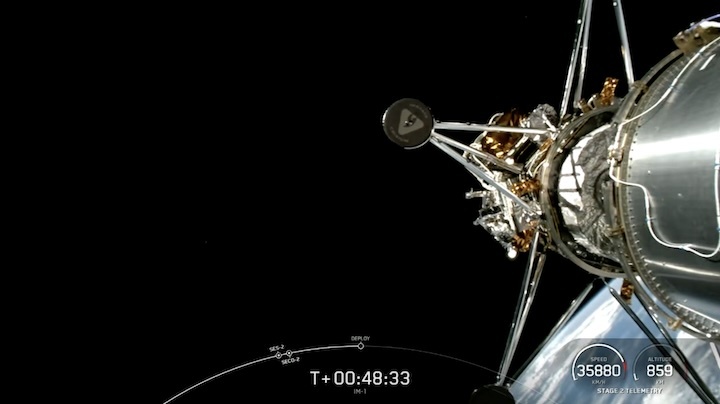
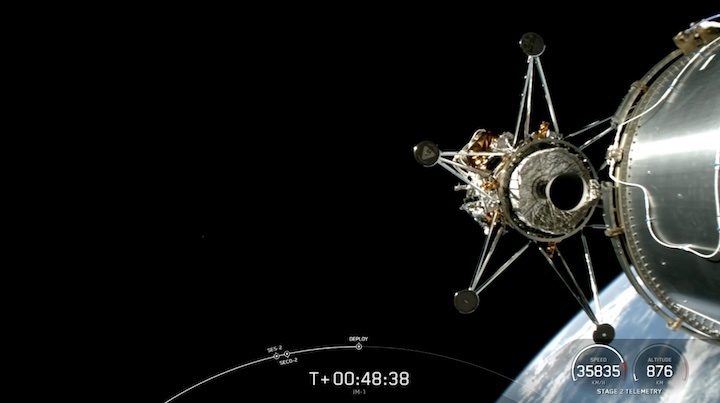
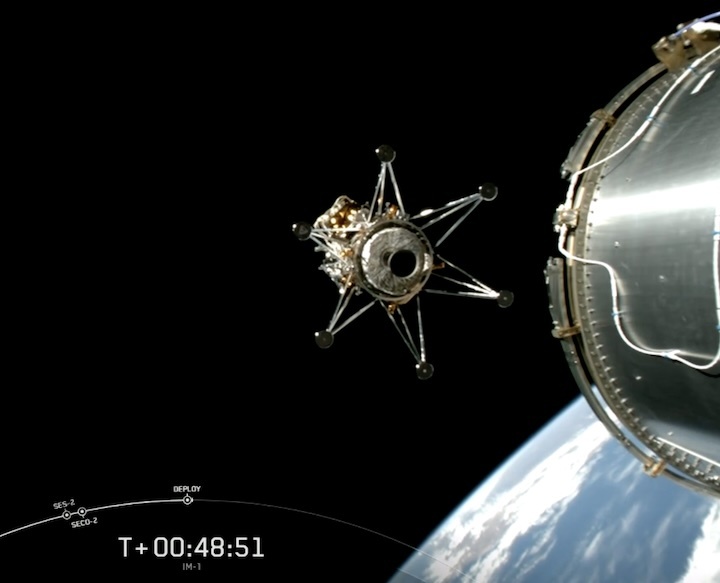
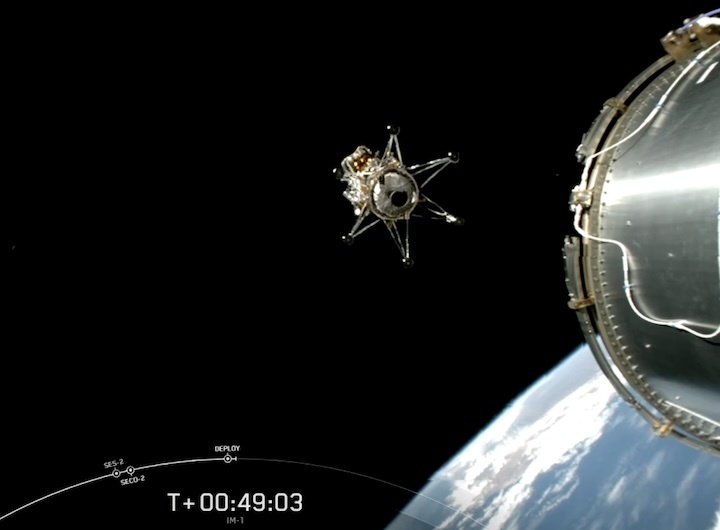
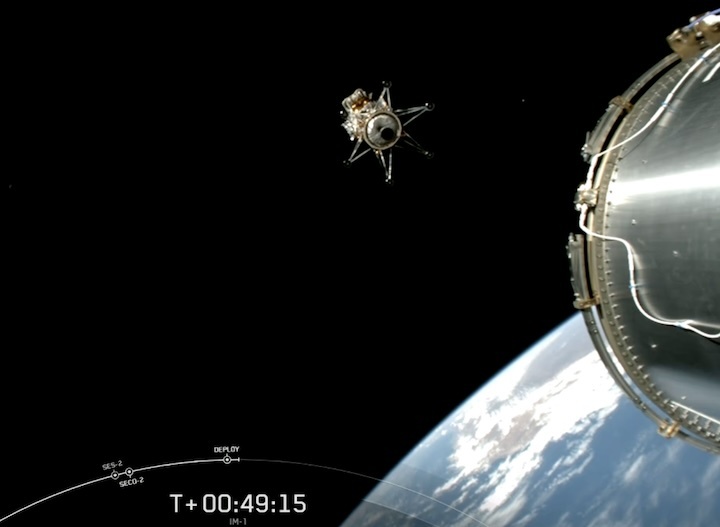
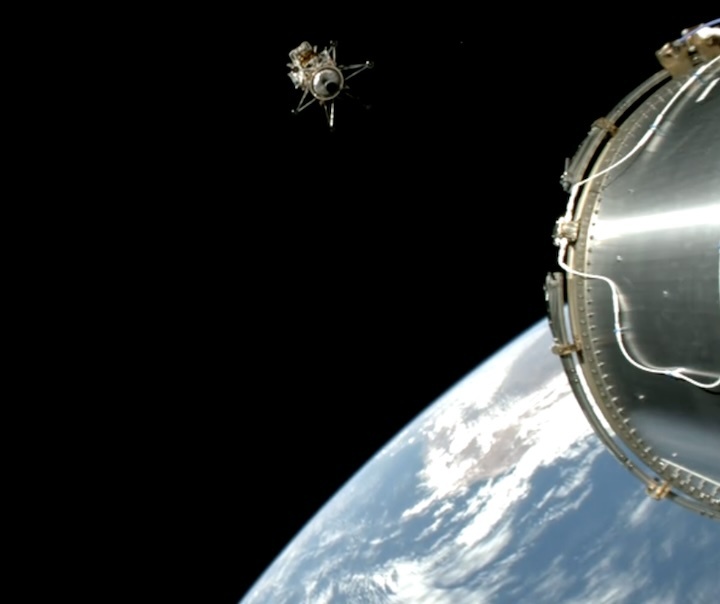
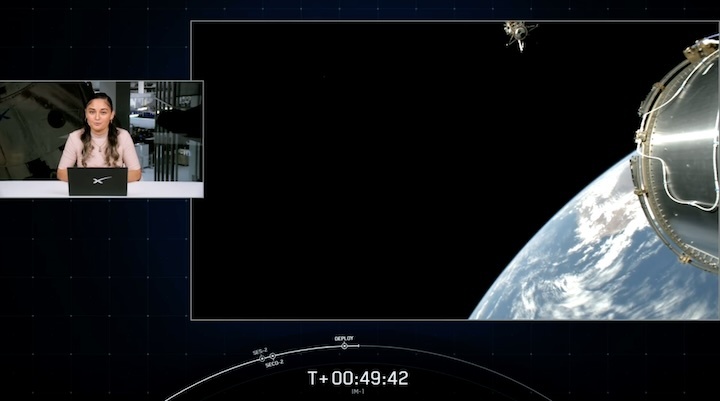
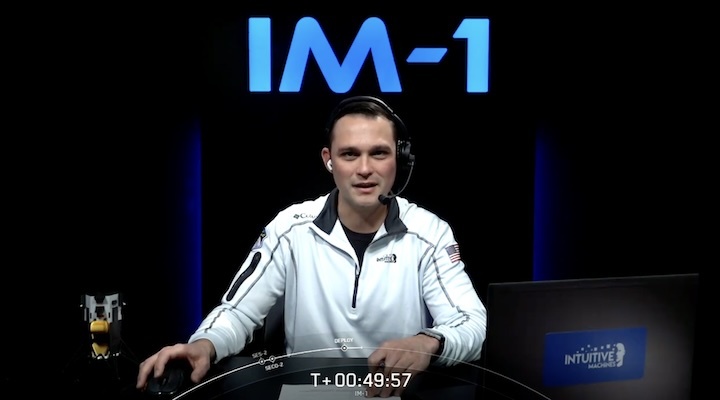
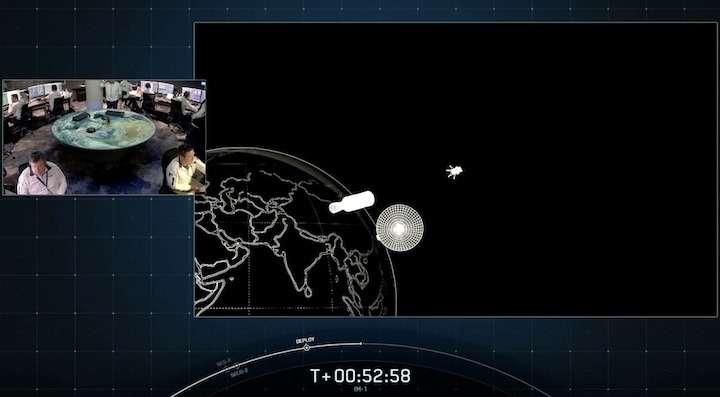
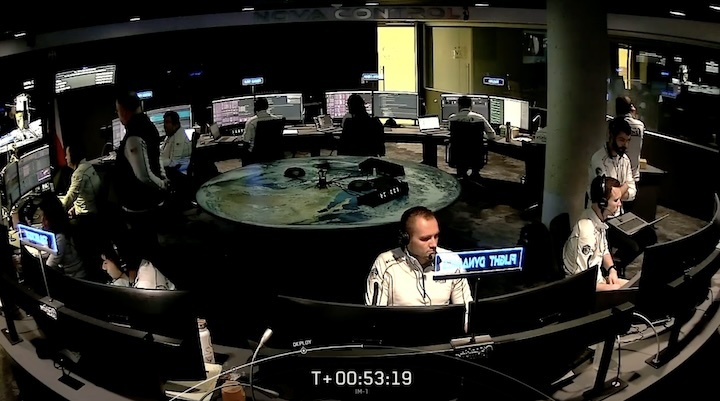
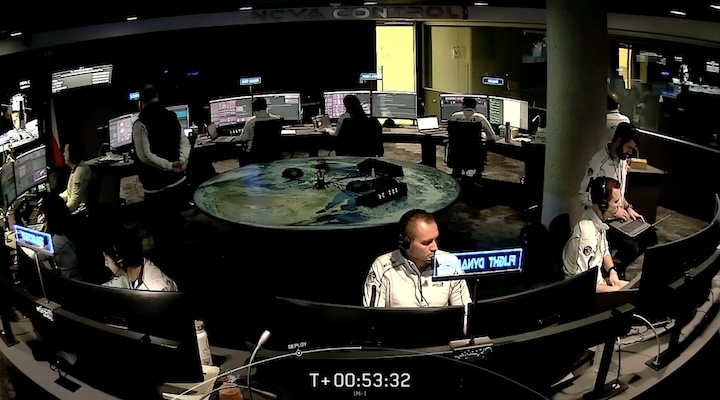
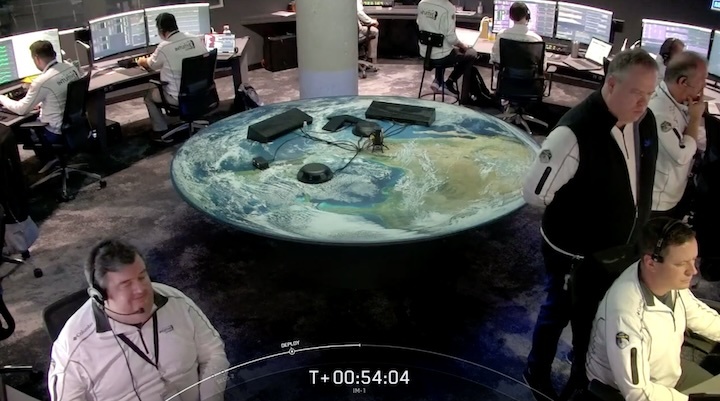
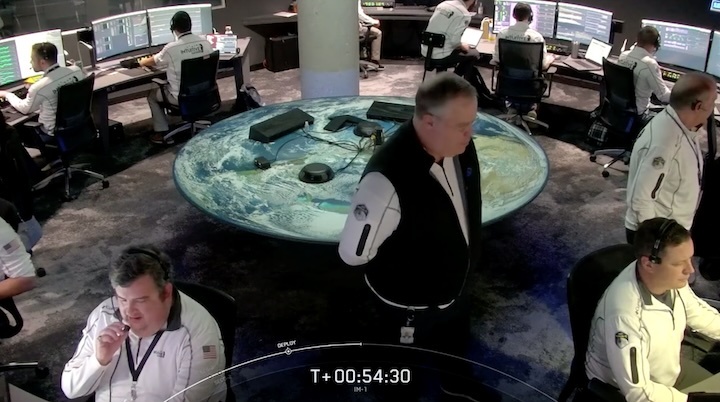
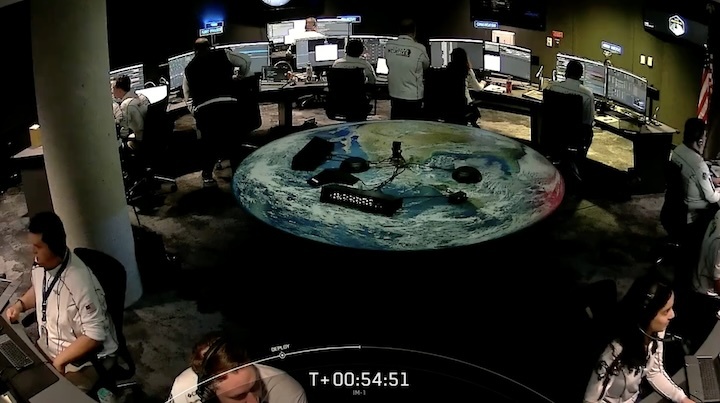
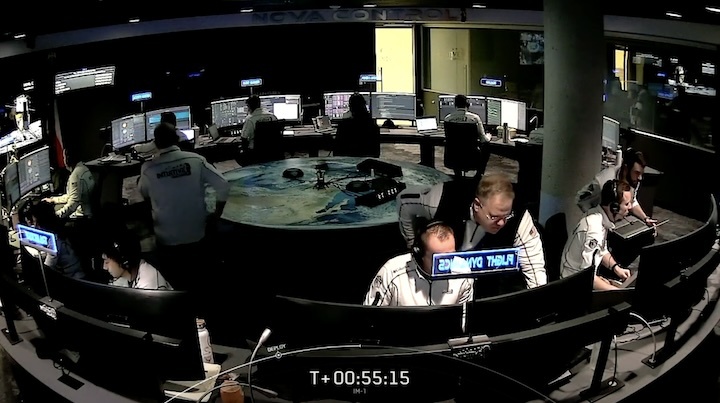
Quelle: SpaceX, NASA

